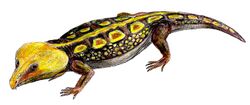Biology:Labidosaurus
| Labidosaurus Temporal range: Early Permian
| |
|---|---|

| |
| Life restoration | |
| Scientific classification | |
| Domain: | Eukaryota |
| Kingdom: | Animalia |
| Phylum: | Chordata |
| Class: | Reptilia |
| Family: | †Captorhinidae |
| Genus: | †Labidosaurus Cope, 1896 |
| Species: | †L. hamatus
|
| Binomial name | |
| †Labidosaurus hamatus (Cope, 1895)
| |
Labidosaurus (from Greek: λᾰβῐ́δος Script error: The function "transl" does not exist., 'forceps' and Greek: σαῦρος Script error: The function "transl" does not exist., 'lizard') is an extinct genus of reptile from the Permian period of North America. Fossils have been discovered in Texas .
It was heavily built, resembling a lizard with a large head, and measuring about 75 centimetres (30 in) long. Unlike many other captorhinids it had a single row of sharp, conical teeth in its jaws, and its dietary habits are assumed to have been omnivorous.[1]
A lower jaw of Labidosaurus was described in 2011 that shows evidence of osteomyelitis, or an infection of the bone. It is the earliest known example of an infection in a land vertebrate. The infection probably developed because the pulp cavity of a broken dentary tooth was exposed to bacteria. Although another tooth would have replaced the broken one, regeneration would have been slow. Labidosaurus and other derived captorhinids had teeth that were deeply implanted in the jaws. This deep implantation limited tooth replacement, meaning that a broken tooth would have been exposed for a long period of time.[2]
References
- ↑ Modesto, Sean P.; Scott, Diane M.; Berman, David S.; Müller, Johannes; Reisz, Robert R. (2007). "The skull and the paleoecological significance of Labidosaurus hamatus, a captorhinid reptile from the Lower Permian of Texas". Zoological Journal of the Linnean Society 149 (2): 237–62. doi:10.1111/j.1096-3642.2007.00242.x.
- ↑ Reisz, Robert R.; Scott, Diane M.; Pynn, Bruce R.; Modesto, Sean P. (2011). "Osteomyelitis in a Paleozoic reptile: ancient evidence for bacterial infection and its evolutionary significance". Naturwissenschaften 98 (6): 551–5. doi:10.1007/s00114-011-0792-1. PMID 21499814. Bibcode: 2011NW.....98..551R.
Wikidata ☰ Q2585658 entry
 |


